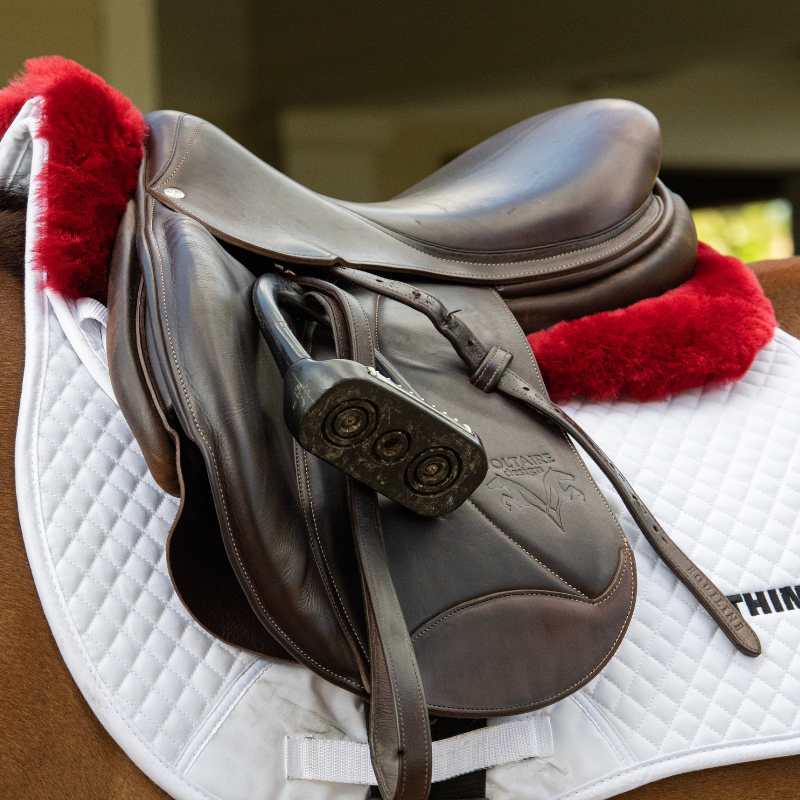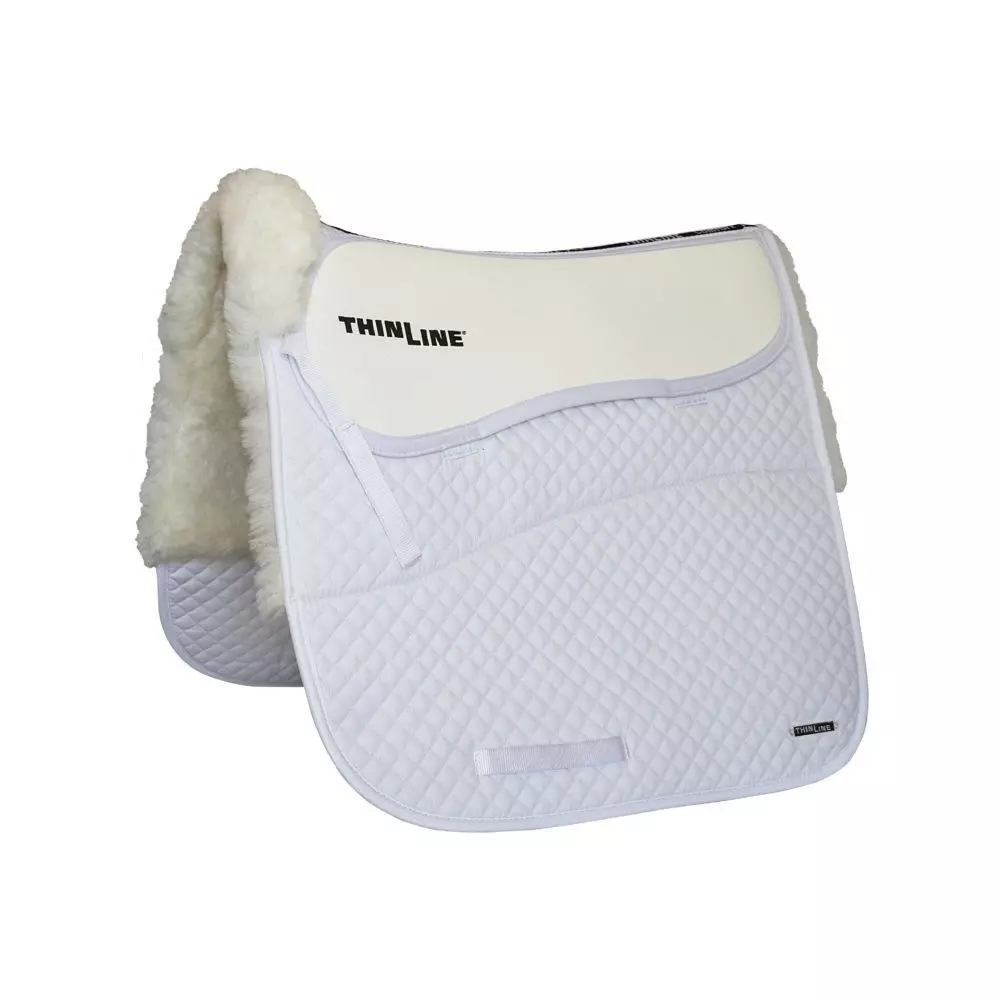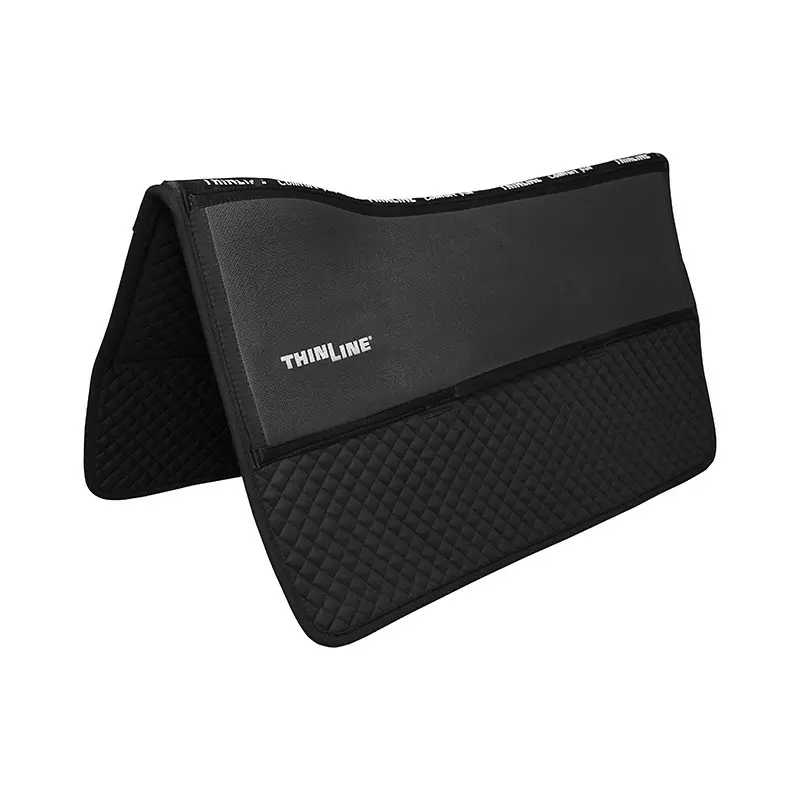Have you ever wondered whether thickness matters when selecting a saddle pad?
You may equate saddle pad thickness with extreme cushioning that provides greater comfort and protection for the horse and rider or as a quick fix to a poorly fitting saddle, but in actuality, that’s not always true.
In fact, sometimes, a thicker saddle pad can do more harm than good.
You may be surprised to learn how saddle pad thickness – or thinness – can impact the quality of your riding and your horse’s performance.
So, let’s take a closer look.

A saddle pad with half pad under the saddle
The Function of Saddle Pads
At the bare minimum, a saddle pad’s primary purpose is to absorb sweat and keep the underside of the saddle clean. That was the original intent of pads.
Beyond this essential function, a saddle pad can also
- cushion and protect the horse’s back
- improve saddle fit
- enhance comfort and stability for the rider
- distribute weight better
The fact is that saddle pads can be a problem-solver for both horse and rider.
But in the grand scheme, saddle pad thickness depends on whether the pad makes riding pleasant for you and your horse. And that depends a lot on the pad’s material.
“Squishy” material that compresses over time moves around, creating pressure points. A thin, shock-absorbing pad constructed with material that doesn’t flatten with pressure generally produces the most comfortable ride.
Also, one other important note: If your saddle fits the horse poorly, you may temporarily be able to correct fitting issues with a saddle pad, but a check-up with a professional saddle fitter is definitely in order.
Assess Riding Needs and Saddle Fit
Some riders may automatically associate a thick saddle pad with providing extra comfort and protection for their horse’s back.
Others may reason that the bulk of a thicker pad may resolve fit or slippage problems resulting from an ill-fitting saddle or the horse’s conformational deficiencies.
Sounds logical.
Nevertheless, the following discussion raises relevant points to examine when choosing a saddle pad.
Riding Discipline
Are you a dressage or hunter/jumper rider? Or a Western rider who runs barrels or reining patterns?
Riders participating in these activities seek closeness with their horses. In addition, these athletic equine disciplines require equipment that doesn’t restrict the horse’s movement.
For these undertakings, a thicker saddle pad could be detrimental.
As some riders describe, too much material between themselves and the horse can create a feeling of “deadness,” which is not a good feeling when executing one tempis or a rollback.
Recognizing this problem, ThinLine has explicitly designed saddle pads to ensure a close feel, unrestricted movement, more shock absorption, and better weight distribution than even one-inch thick pads.
For dressage or hunter/jumper riders, the Cotton Quilted Saddle Pad is 80/20 poly/cotton with ThinLine shock-absorbing panels on both sides of the pad’s topline. The thin panels—only 3/16 inches—are made of non-slip, breathable foam that absorbs shock for both horse and rider. (ThinLine is the only pad endorsed by back surgeons, veterinarians, and master saddle fitters.)
The Woven Wool Square Dressage Pad is ideal for dressage competitors. It, too, has slim ThinLine panels attached to the pad’s topline to lessen shock but includes protective woven merino wool on the underside for excellent moisture, weight, and additional shock absorption.

Woven Wool Dressage Pad
Both saddle pads are shimmable, which aids in adjusting saddle fit due to asymmetries with your horse or minor saddle fit issues.
Reviewers have commented that even with the shims, the pad thickness was “just right.”
For Western riders, a feeling of closeness is vital.
Western riding is known for explosive starts, sliding stops, and turns on a dime. A saddle pad that doesn’t shift, slip, or interfere with the horse’s movement is critical.
And with all that intense physical activity, there’s a lot of shock to be absorbed by horse and rider.
ThinLine offers multiple Western Saddle Pad options to give riders their best ride.
All our Western saddle pads have slim, shock-absorbing ThinLine panels sewn onto assorted textile materials of varying thicknesses and shapes.
With so many pads, we recommend the Western Cotton Liner Pad as a starting point. It’s one of ThinLine’s thinnest, making it ideal for those looking for an excellent close feel with their horse. It is made of heavy-duty washable cotton with wool fill and a wither profile.

Western Cotton Liner Pad
Even with the protective panels, this cotton liner pad is so thin that riders can add a fancy show pad on top without altering their saddle’s fit.
Okay. So what about riders who spend hours in the saddle, like Endurance riders or Cowboys?
They prefer a pad that offers comfort, protection, and breathability without shifting, slipping, or rubbing.
ThinLine’s lightweight Endurance Saddle Pads meet these expectations.
ThinLine panels are attached to the pads’ contoured toplines to stabilize the saddle and evenly distribute weight to eliminate pressure points.
The Cotton Endurance Drop Rigging Saddle Pad also has ThinLine material on the drop rig protective shield. It fits most drop- or centerfire-rigged endurance saddles, including Australian and treeless ones.
And, like all ThinLine pads, they are shimmable.
Saddle Fit & Horse Conformation
No matter your riding type, how the saddle fits your horse, and you is vitally important.
Poor-fitting saddles can wreak havoc on your horse. Depending on the issue, they can rub and create sore spots or cause significant injury.
Some fitting concerns can be resolved with the right saddle pad (and guidance from a certified saddle fitter.) In these cases, a thicker pad may do the trick.
In other situations, using saddle pad shims may allow you to make temporary adjustments so the saddle’s fit can adapt to the horse, for example, as a young horse’s body develops with training.
Some horses have conformational challenges that can be managed with an appropriately designed saddle pad. For example, high-withered and mutton-withered horses present opposing problems for riders.
A horse with prominent withers needs a cut-back saddle pad design compared to a horse with little or no withers. In short, the pad should accommodate the horse’s topline.
Be sure to assess the problem or problems you’d like to address and determine if and how a saddle pad could help.
Final Points
When choosing the right saddle pad, thickness is only a minor consideration.
Far more important are the materials used in the pad’s construction. Avoiding fat, squishy, easy-to-compress material eliminates the chance of painful pressure points.
What also matters is your riding discipline, the fit of your saddle, and whether your saddle pad helps or hinders you and your horse’s performance.
ThinLine wants horses and riders to achieve excellence, whether competing in the show ring or enjoying a leisurely trail ride.
Because we know the rigors of equestrian pursuits, our non-slip saddle pads provide shock-absorbing protection, comfort, a feeling of closeness, and a superior fit that sustains both horses and riders in their respective disciplines.
The right saddle pad can make all the difference in your riding experience.


